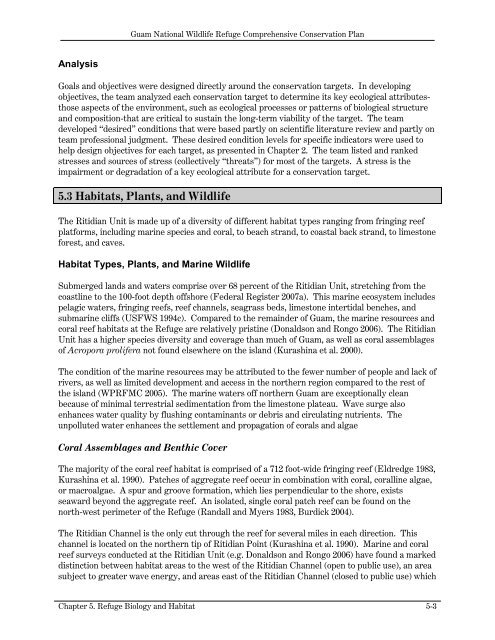Guam National Wildlife Refuge Comprehensive Conservation Plan
Guam National Wildlife Refuge Comprehensive Conservation Plan
Guam National Wildlife Refuge Comprehensive Conservation Plan
You also want an ePaper? Increase the reach of your titles
YUMPU automatically turns print PDFs into web optimized ePapers that Google loves.
Analysis<br />
<strong>Guam</strong> <strong>National</strong> <strong>Wildlife</strong> <strong>Refuge</strong> <strong>Comprehensive</strong> <strong>Conservation</strong> <strong>Plan</strong><br />
Goals and objectives were designed directly around the conservation targets. In developing<br />
objectives, the team analyzed each conservation target to determine its key ecological attributesthose<br />
aspects of the environment, such as ecological processes or patterns of biological structure<br />
and composition-that are critical to sustain the long-term viability of the target. The team<br />
developed “desired” conditions that were based partly on scientific literature review and partly on<br />
team professional judgment. These desired condition levels for specific indicators were used to<br />
help design objectives for each target, as presented in Chapter 2. The team listed and ranked<br />
stresses and sources of stress (collectively “threats”) for most of the targets. A stress is the<br />
impairment or degradation of a key ecological attribute for a conservation target.<br />
5.3 Habitats, <strong>Plan</strong>ts, and <strong>Wildlife</strong><br />
The Ritidian Unit is made up of a diversity of different habitat types ranging from fringing reef<br />
platforms, including marine species and coral, to beach strand, to coastal back strand, to limestone<br />
forest, and caves.<br />
Habitat Types, <strong>Plan</strong>ts, and Marine <strong>Wildlife</strong><br />
Submerged lands and waters comprise over 68 percent of the Ritidian Unit, stretching from the<br />
coastline to the 100-foot depth offshore (Federal Register 2007a). This marine ecosystem includes<br />
pelagic waters, fringing reefs, reef channels, seagrass beds, limestone intertidal benches, and<br />
submarine cliffs (USFWS 1994c). Compared to the remainder of <strong>Guam</strong>, the marine resources and<br />
coral reef habitats at the <strong>Refuge</strong> are relatively pristine (Donaldson and Rongo 2006). The Ritidian<br />
Unit has a higher species diversity and coverage than much of <strong>Guam</strong>, as well as coral assemblages<br />
of Acropora prolifera not found elsewhere on the island (Kurashina et al. 2000).<br />
The condition of the marine resources may be attributed to the fewer number of people and lack of<br />
rivers, as well as limited development and access in the northern region compared to the rest of<br />
the island (WPRFMC 2005). The marine waters off northern <strong>Guam</strong> are exceptionally clean<br />
because of minimal terrestrial sedimentation from the limestone plateau. Wave surge also<br />
enhances water quality by flushing contaminants or debris and circulating nutrients. The<br />
unpolluted water enhances the settlement and propagation of corals and algae<br />
Coral Assemblages and Benthic Cover<br />
The majority of the coral reef habitat is comprised of a 712 foot-wide fringing reef (Eldredge 1983,<br />
Kurashina et al. 1990). Patches of aggregate reef occur in combination with coral, coralline algae,<br />
or macroalgae. A spur and groove formation, which lies perpendicular to the shore, exists<br />
seaward beyond the aggregate reef. An isolated, single coral patch reef can be found on the<br />
north-west perimeter of the <strong>Refuge</strong> (Randall and Myers 1983, Burdick 2004).<br />
The Ritidian Channel is the only cut through the reef for several miles in each direction. This<br />
channel is located on the northern tip of Ritidian Point (Kurashina et al. 1990). Marine and coral<br />
reef surveys conducted at the Ritidian Unit (e.g. Donaldson and Rongo 2006) have found a marked<br />
distinction between habitat areas to the west of the Ritidian Channel (open to public use), an area<br />
subject to greater wave energy, and areas east of the Ritidian Channel (closed to public use) which<br />
Chapter 5. <strong>Refuge</strong> Biology and Habitat 5-3

















